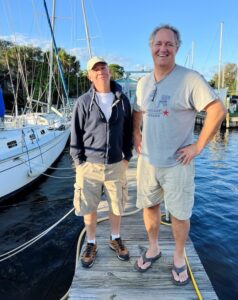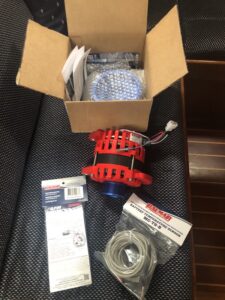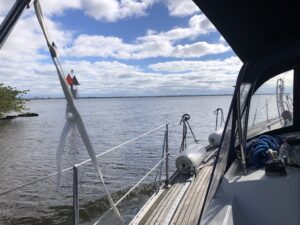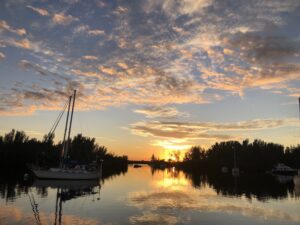Recap: Florida…and Another Breakdown, Really?
The plan for Jill and I was to hang out in Port Canaveral for a night or two while a cold front swept through the region and then jump back offshore and head down the coast to the Lake Worth Inlet area around West Palm Beach. That’s the spot where cruisers stage and wait for a weather window in which to cross the Gulf Stream to the Bahamas. From Lake Worth Inlet to West End on Grand Bahama Island is about fifty-six miles, or eight to ten hours, on a sailboat.
But as we’ve seen in this fall/winter of 2023-2024, the weather gods had other ideas. The forecast opportunities to head south weren’t of long enough duration to make it definitively to the next inlets safe enough (read: deep enough) for Further to enter. So after three nights at Cape Marina, we took another tack: Jill and I turned Further west, entered the Canaveral Lock to the Canaveral Barge Canal and returned to the ICW (groan).
It gets better: around about the time we exited the lock and crossed the Banana River to enter the canal, the skies opened up and it started pouring.
But wait, there’s more.
A couple of hours down the ICW I noticed that the electrical system was having issues. I checked the battery monitor and the voltage was dropping rapidly, and it wasn’t being replenished by the alternator running off the engine (as would be normal). By the time we got about five hours down the ICW in the Melbourne, Florida, area, the battery voltage was dangerously low, so much so that the icebox had shut down, and soon after it, the normal refrigerator went down too.
We anchored just east of the ICW below the Eau Gallie Bridge and I shut down everything electrical. I started texting my friend Butch, an electrician aboard his own boat with his wife, Lynn, in the eastern Caribbean, who guided me as to next steps. Long story short: the alternator must have been toast. I was a wreck all evening (although we did get to see a SpaceX launch back at Canaveral; would have been better from the marina where we’d been but…oh well) and in the morning started up the engine just to make sure it WOULD start—that there was sufficient battery juice to get it going. Thankfully, it did start and I immediately started looking for a marina nearby.
Fortunately, there was one right across the ICW: the Eau Gallie Yacht Basin. The owner, Mike, replied that he could squeeze Further in near the boat lift, and he also knew a guy who could take a look at the electrical problem. We motored across, got tied up to the dock and settled in, and I tracked down Mike’s referral, Jon Thomas. Jon came out to the boat that afternoon and removed the defunct alternator. He had a a resource who could test the alternator and rebuild it if necessary, but that it would take a few days. So with that, Jill and I settled into the EGYB on MLK Day.
Which turned out to be a wonderful surprise. The Eau Gallie Yacht Basin is an old-school marina, with good amenities for people who like and use boats, and none of the bells and whistles that modern corporations are applying to marinas in an effort to boost the bottom line. The showers are great, the laundry machines are too, there’s a great lounge to rest and work in, and best of all, the people at EGYB are wonderful. There’s a weekly potluck dinner around the fire pit, but even during the course of the day people interact, chat and help each other with various boat issues. The marina is also nestled into a little cove on the western side of the ICW/Indian River, so it’s a safe and secure place to be whenever those infamous Florida thunderstorms roll through.And if that’s not enough, the water teems with life both above (bird) and under (fish) the surface—I even saw two manatees right in the slip alongside Further, my first manatee sighting ever. And on top of all that, the area around the marina is a nice section of Melbourne with an arts district, a legit hardware store, several restaurants (including a hot dog place that RULES) and a good brewpub with great outdoor seating and live music.
Which all came in handy since the alternator was, in fact, toast. Jon’s contact rebuilt the thing and, after the weekend, we reinstalled it and tried it out. No go. What caused the problem is the same thing that was rendering the alternator unusable: Further’s lithium-ion battery bank. I think what happened is that when we left Canaveral, I hadn’t topped off the batteries and they were lower than normal. Lithium batteries are pigs and they tried to suck so much energy out of the engine/alternator that they burned up the alternator. And while that alternator was a bit oversized for the engine, it was insufficient for the battery bank on Further.
I wound up ordering a new alternator and a couple of accessories from a company in Maine that would help the external alternator controller keep better tabs on the system. I also needed to reprogram the controller—when it was installed back in Annapolis, it wasn’t set up properly so it didn’t keep things, well, under control. I did a bunch of research online and figured out how to do that, and Jon helped with the alternator installation (which required a modification to the engine) and, after almost two weeks, lo and behold, it seemed the electrical system was back online.
By this time, Jill had departed, heading over to Tampa took look at a boat she was interested in. She was then headed back north to join her previously scheduled sailing delivery out of Jacksonville.
And by this time also, Jon Thomas had turned out to be a fantastic resource. He was super helpful, not only with the alternator but with a few other quick-fix items (like soldering a power plug at the helm for my navigation iPad) and various other boat ideas/alterations I’d had on my list. He was really helpful with what to do while in Melbourne and even provided information for heading farther south in Florida and over to the Bahamas.
Yes, it was a serious drag to have had another major (read: expensive) breakdown on Further, but to have found a great place like the Eau Gallie Yacht Basin and a great new friend in Jon Thomas, well, that was an unexpected nice surprise. And, to be honest, in hindsight, I’m glad the breakdown happened where it did; if it had occurred in the Bahamas I’d have been up a serious creek without a paddle.
So it was that two weeks after arriving at EGYB, Further and I, with our new (aforementioned in an earlier post) crew, resumed our journey down the ICW, still hell-bent on getting to the Bahamas.
And glory be, the new alternator worked gangbusters! Yes, we did a test run on the Indian River the day before departing, but this was its first hard, nonstop run and not only did the alternator charge the batteries but the controller (dialed down a bit from maximum) kept everything within parameters. Electrically, Further was back in business.
Our first stop was about five hours south in Vero Beach. We took a mooring ball at the Vero Beach City Marina, a cheap alternative to a slip that meant using the dinghy to get anywhere. But it also meant being what turned out to be a great spot with a lot going on, much like the marina in Brunswick, a lot of resources in the vicinity and a very pleasant place to settle in. The area is known among cruisers as “Velcro Beach” (also much like Brunswick) because it has so much going for it at a very affordable price. The lack of easy ocean access—the nearest inlet for a sailboat is a couple of hours away—would keep me from settling in there TOO long, but I can definitely see why people arrive there and then can’t tear themselves away.
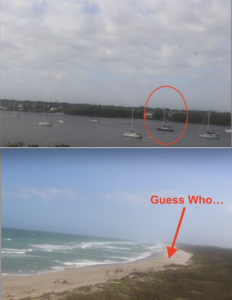
The national wildlife refuge webcam at Peck Lake caught Further at anchor and you-know-who on the beach
Still, tear ourselves away we did, motoring another four hours south to a wide spot in the ICW called Peck Lake, located in between Stuart and Hobe Sound. I think it might have been a lake in days of old but when they dug the ICW it assumed its present-day form. What was really nice about Peck Lake, though, was that the barrier-beach island protecting it and the ICW and the mainland from the Atlantic Ocean was a national wildlife refuge, so there are no homes, no buildings, no nothing on a delightful white-sand beach. You can walk several miles in either direction. You can swim in the ocean. Hell, you can just sit in the sun and do nothing (as I did a few times) if you want. It was a lot like the refuge back on my home barrier-beach island, and I thoroughly enjoyed it. Yes, on the weekend the place got overrun with teenagers racing around in speedboats and on jet skis, but other than that, it was almost pristine.
And it was free to anchor there, which was a good way to affordably kill a few days waiting for the forecast to open up a window for a Gulf Stream crossing. We still had a few hours to go to get down to Lake Worth Inlet, but minimizing our time there was my plan.
After four days at Peck Lake, we did indeed cover those few hours, encountering for the first time that wonderful turquoise water in the Jupiter Inlet area. We made it to the Riviera Beach City Marina where I’d reserved a slip and prepared for the jump to the Bahamas. A run to Costco, several runs to the local grocery store, a visit to a fishing store and a dive shop took up the three days we were in Riviera Beach. We also managed to fit in a snorkeling run on a little “trail” that area has laid out, as well as an exploratory walk around Peanut Island, a dune in the middle of the lagoon that JFK would retreat to when he was president. The whole area is a little too crowded for my taste, but it was a nice play to get ready to sail to another country. Which we would finally do on Feb. 15.
